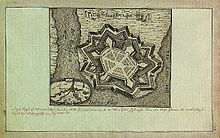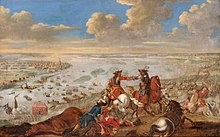Saxon Livonia Campaign
The Saxon Livonia Campaign from February 1700 to the end of October 1700 marks the military operations of the Saxon Army in Swedish Livonia at the beginning of the Great Northern War . The aim of the campaign was to conquer the Swedish Livonia province with the main fortress of Riga . The Saxons only succeeded in conquering a few subordinate fortress locations, while Riga was besieged without success. The inferior Swedish forces knew how to force the Saxons to retreat again and again by skillful maneuvering . There was, however, no open decisive battle. The campaign was not decided militarily for Sweden until the following year with the Battle of the Daugava .
Deployment of the Saxons
Saxon and Danish negotiations had previously agreed on a mutually offensive action against Sweden. While Denmark wanted to appropriate the territory of Holstein-Gottorp , which was dependent on Sweden , the Polish King and Saxon Elector Augustus the Strong planned an invasion of Swedish Livonia. At first, Saxon diplomats operated deceptive maneuvers at the diplomatic banquet and appeased the Saxon troop movements with all sorts of excuses. Despite August II's promise to withdraw all Saxon regiments from Polish territory in the Polish Sejm at the end of July 1699 , he promised the Courland Duke 5,000 men of the Saxon army to support him. For this purpose General Field Marshal Jacob Heinrich von Flemming was entrusted to march with these troops to Lithuania and to await further support there.
Saxon artillery was brought from Dresden to Lübeck and from there shipped by sea via Danzig to Polangen in Lithuania.
Meanwhile, the Saxon troops marched to Janitski, which was 12 miles from Riga, and set up their headquarters there. In December 1699, the existing Saxon troops in Courland went to winter quarters. The Swedish troops in Livonia under the command of Erik Dahlberg then began to mobilize and increase the level of defense. Several letters from the Saxon side had contributed to this, including from Johann Reinhold von Patkul to Dahlberg, the city commandant of Riga, which contained open threats. The Swedes now systematically scouted the border with Courland. In February 1700 several Saxon dragoons deserted and fled to Riga. Dahlberg refused to hand over the deserters, which deepened the diplomatic conflicts.
Start of hostilities
Main battles of the campaign:
|
A Saxon ruse to capture Riga by covertly smuggled soldiers in February failed at the outset. Several soldiers on both sides were killed in the incident and the Riga city garrison were warned in good time. That was also the beginning of open hostilities. Just one day later, on February 22nd, 1700, Flemming had his troops advance on Riga and crossed the Swedish-Livonian border without declaring war .
The troops of the Saxons consisted of three infantry regiments (Guard, Queen, Bornstadt) with a nominal strength of 2250 each and four dragoon regiments (Weissenfels, Flemming, Sanosth, Wolffenbuttel) with a nominal strength of 900 each and six three pounder field cannons . Altogether there were about 10,350 men out of 18,000 men in the Saxon army that were in front of Riga. In February 1700 there were four and a half infantry regiments with 6000 men and two cavalry regiments with 1000 men in the Swedish Baltic provinces. However, of these only 20 companies of the Riga Government Regiment under Dahlberg and the Riga Garrison Regiment under Erik Soop with a total of 3000 men were stationed in Riga itself. The other troops were distributed to the other Swedish festival locations Narva, Reval, Dorpat , Pernau , Nyland.
Initially, the Saxon advance was directed against the Koberschanze , which was on the other side of the river and opposite Riga and formed a fortified outpost. The fort was in ruins and consisted of four to five bulwarks with a crew of 50. On February 24th, the fortress was attacked by 2000 Saxons within two hours and occupied by 1000 men.
Dahlberg burned down the suburbs of Riga to get a free line of fire for the fortress artillery . The Düna was frozen over at this time, so that the Saxons threatened to advance across the river. But Flemming considered his strength to be too low for an attack on the river side of the city fortress and failed to advance. Patkul's efforts on the Livonian side to instigate an uprising by the long-established nobility against Swedish supremacy failed at the outset, so that the Saxons' original hope of taking the province by storm faded at this point. In the meantime, limited Saxon bombardment began on Riga with the sixteen guns captured in the Koberschanze, four other heavy guns and three mortars . The city itself received reinforcements from 400 Swedish dragoons .
Conquest of the Dünamünder Schanze
Riga continued to receive support from the sea. The Dünamünder Schanze was located a few kilometers downstream from the Düna . She guarded the river access to the Baltic Sea . On March 16, 2000 Saxons marched in front of the hill and began the siege. The first assault on March 24th was still repulsed. The fortress was handed over to the Saxons on March 26th. The crew was allowed to withdraw to Reval . The Saxons also occupied this hill with 1000 men.
The Saxons were still unable to besiege the city and only blocked the entrances to the city. August's efforts in Warsaw to get Poland and Lithuania to participate in the war failed. The nobility refused to interfere in the conflict with Sweden and prevented Polish support with arms and finances. In the Saxon army command, Patkul took over command of the troops for Flemming, who was staying in Warsaw. His inexperience in the military field had a negative effect on the conduct of operations in the Saxons. He first led his troops to Kupfermühlen, four miles from Riga. From there he marched with the army corps on to Riga to Neumühlen , about 25 kilometers north of Riga and then on to Jungfernhof, about five kilometers from Riga.
Swedish offensives
Meanwhile Major General Georg Johann Maydell led the Swedish troops. The Swedish general learned from the Saxon troop movements that the Saxons lacked strategic operational capabilities so that he could carry out his own offensive efforts. First, the Swedes attacked the Saxon troops in the city of Wenden . After a short skirmish, the Saxons evacuated the city and withdrew. At Jungfernhof , the Swedes deployed some of the Saxon troops on May 17, 1700 and attacked the well-entrenched Saxons. After a brief skirmish, the Saxons also withdrew from this pass. As a result of the movements, the Saxons were now back on their original territory at the beginning of the campaign, so that Riga had free access again. The Saxons received further reinforcements and holed up along the Daugava.
In June, the Swedish governor Otto Vellingk from Narva arrived in Riga with several thousand reinforcements and took over command. With this, the Swedes achieved roughly equal strengths with the Saxon troops. Nevertheless, the Swedes did not undertake any offensive undertakings against the Saxon camp on the other side of the Düna or the Dünamünder Schanze, which remained in Saxon possession. It was not until the beginning of July that the Swedes undertook a limited offensive action against the Saxons when 500 men crossed the Daugava and attacked two Saxon entrenchments. They captured more than 80 Saxons.
Arrival of the Saxon reinforcement
At the same time, the Saxon reinforcements arrived under the command of Field Marshal Adam Heinrich von Steinau on the Düna. It consisted of 11,000 Saxons, 3,000 Lithuanians, several hundred men from the Polish royal bodyguard and 1,200 Tatars . A Saxon attempt to cross the Daugava at Magnusholm was thwarted by the Swedes. They now built a bridge further upstream at Jakobstadt . The Swedes received news of the Saxon efforts from an outpost and set out on July 27th with the entire armed forces from their army camp in front of Riga and marched towards the Saxons to Probstinghof (today in Lielvārde ). At a meeting but both army did not happen because the Saxons dodged the battle offered the Swedes. On July 31, about 150 Swedes crossed the Daugava to scout out the Saxon positions; there it came to several small skirmishes with light cavalry without decision-making character.
A few hours later the Saxon army crossed over. It now consisted of 15,000 men and was clearly superior to the Swedish army under Vellingk, which numbered 8,000 men. The Saxons had no intention of engaging in a battle with the Swedish army, but wanted to occupy the conveniently located passes at Neumühlen and Smeising and thus cut off the Swedish army on the land side from Riga. So there was only a brief encounter between some Swedish squadrons and the advancing Saxons on the left wing of the Swedish army , and a small battle in which the Saxons withdrew. The Swedes lost 23 dead and 10 prisoners with roughly the same losses among the Saxons. Vellingk now sent the majority of his army, about 5,000 men, back to Riga and raised the rest of the troops in the country to prevent the raids of the Cossacks in the Saxon service.
Another siege of Riga
The Saxon troops now marched on Riga and began the siege of the fortress again on August 7, 1700. Shortly afterwards, the bombardment of the Saxon artillery began, but without having any concrete effect. On September 19, 1700, the siege was surprisingly lifted by the Saxon army. Around the same time, Sweden had signed the Traventhal Peace with Denmark , which meant that Saxony lost its most important ally in the fight against Sweden. In addition, there was now a threat of an invasion of Sweden into the electorate or a relief of Riga by Charles XII. personally. At the diplomatic banquet, several exchanges between the European states that sought peace with Sweden followed in the following weeks. However, the situation worsened again when the Russian army invaded Swedish-Ingermanland and besieged Narva .
Conquest of Kokenhusen
The Saxon army under Matthias Johann von der Schulenburg started moving again and on October 8, 1700 began to besiege Kokenhusen Castle, some 85 kilometers from Riga, in what is now Koknese , probably with the aim of creating favorable starting conditions for a new campaign in to procure next spring. After three days of bombardment, the Swedish occupation under Major Heinrich Hein surrendered to the Saxons. The Saxons left 600 men in the castle and withdrew completely from the Riga area. Before that, they destroyed the trenches and batteries . At the same time, the two warring parties agreed a local armistice in front of Riga for a period of eight days so that the Saxons could transport their artillery across the Daugava. It was composed of 103 guns of various types. The infantry went to winter quarters in Courland, the cavalry in Lithuania.
consequences
The next year, the army defeated Charles XII. the Saxon army on July 19, 1701 in the battle of the Daugava . All of the fortresses conquered from the previous Saxon campaign fell back to the Swedes. These continued their campaign and penetrated further into Courland, and subsequently occupied all fixed points there.
literature
- Jöran Andersson Nordberg: Life of Carl the Twelfth, King in Sweden: with coins and cooper , Johann George Trausold, 1745






